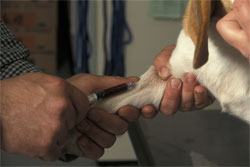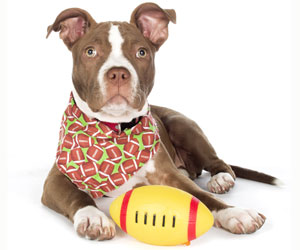Dog DNA and Humans

Then came Darwin, Mendel, and Watson and Crick. The last century has seen more changes in dog breeding than the past 10 centuries combined. In the 20th century, researchers such as Stockard, Warner and Humphries, and Scott and Fuller undertook hundreds, if not thousands, of experimental crosses. But by the last quarter of the 20th century, large-scale dog genetic projects were gone, largely because dog-breeding studies took too much time, space and money.
A few researchers maintained small genetic projects. Gregory Acland and Gustavo Aguirre were searching for answers to progressive retinal atrophy (PRA) inheritance in dogs. Their pedigree analyses and crosses between breeds showed that several types of PRA existed, most of which were recessively inherited. Breeders clamored for some way to identify carriers, but without information about the dog genome, finding the gene and devising a DNA test was only a dream.
That dream started to materialize when Jasper Rind, a yeast geneticist, became interested in the inheritance of canine behaviors such as herding and swimming and ran into the same roadblock as Acland and Aguirre. But Rind was acquainted with the process of building genetic marker maps, so he assigned his post doc, Elaine Ostrander, to the task of building one for the dog.
Pressing forward
The project began slowly but got a boost in 1996 when Ostrander joined forces with Acland and Aguirre, giving her access to their samples and pedigrees. Their combined efforts produced the first rough map of the dog genome, with 150 markers. It didn’t pinpoint the gene for PRA, but it narrowed down its location to one chromosome.
Funding was still scarce because mice, not dogs, were the accepted animal model for human hereditary disease. That changed in 1998, when researchers discovered the mutation causing narcolepsy in Dobermans. Human narcolepsy researchers used the information from the narcoleptic dogs to better understand the process in people, something mouse research hadn’t provided. If dog genetic research was applicable in this case, why wouldn’t it be applicable in others?
In fact, dogs make ideal candidates for genetic research that can help people. They share many of the same diseases and environmental risk factors as humans, and they have highly distinctive breeds with distinct disease predispositions. Some breeds have been essentially inbred for hundreds of generations, and most dogs come with generations of known pedigrees. These reasons, among others, convinced the National Institute of Health to provide the funding needed to create a complete genome map of the dog.
It was completed ahead of schedule, and as technologies improved, maps based on other dogs were added in a fraction of the time the first map took. By comparing sequences from several dog breeds, researchers have identified 2.5 million places on the genome where changes in a single nucleotide frequency often occur, accounting for the variation we see in dogs. These single nucleotide polymorphisms (SNPs) may soon be available in a public database called “CANMAP.”
Because dogs are more inbred than people, finding individual genes responsible for a disorder is comparatively easy. Generations of inbreeding result in sections consisting of millions of bases of identical DNA within a breed, as compared to only tens of thousands in people. And because breeds descend from only a few founders, a hereditary disorder found in a breed tends to arise from the same mutation in every affected member of that breed. This differs from the case in people, or even mixed breeds, in which it’s possible for diseases that look the same to be caused by different mutations.
By comparing genetic maps from different breeds, researchers estimate how closely breeds are related to one another. This makes it easier to home in on mutations for diseases shared by related breeds because such mutations probably come from the same founding stock. When a similar-appearing disorder occurs in a distantly related breed, it’s more likely to arise from separate mutations. Collie Eye Anomaly, for example, occurs in several related herding breeds. This made it easier for researchers to narrow down the candidate genes to only a few that were shared by four different related breeds with the disorder.
Human-canine DNA
Which brings us back to the gene for PRA. At first glance, dogs with PRA seem to have the same disorder. But Acland and Aguirre’s early research had shown that different breeds get different types of PRA. The gene for the most widespread form of PRA, progressive rod-cone degeneration (prcd), was among the first genetic mutations located in the dog. Since then, DNA tests have been developed for many canine hereditary diseases, including other types of PRA, von Willebrand’s disease, cystinuria, and others. Of course, some tests don’t quite make the list of Nobel Prize eligibility, but they’re still useful – and popular. In fact, some ongoing research is now aimed at finding genes associated with normal conformation differences such as skull and limb length and hair types.
In a few recent studies, the use of SNPs allowed the researchers to pinpoint target genes using just a handful of dogs. In one case, fewer than two dozen dogs were needed to track down the mutation responsible for white coat color in Boxers. It turns out that white Boxers really are different from your average white dog. The white is caused by the same mutation found in people with Waardenburg syndrome, which causes pigment abnormalities and hearing loss. The ability to use just a few dogs to find mutations opens the door for mapping less widespread conditions.
Success is often measured by funding. The AKC Canine Health Foundation and the Morris Animal Foundation both continue to fund genetic studies. Both organizations recently contributed to the $2.2 million needed for startup funds for the Pfizer Canine Comparative Oncology and Genomics Consortium (Pfizer contributed more than $1 million), which is gearing up to collect tissues and fluids from 3,000 dogs over the next three years. And thanks to a grant for $16 million, European researchers have recently organized LUPA, a consortium of 20 universities. They plan to gather DNA samples and health histories from 8,000 dogs, using the data to look for genes for 18 diseases.
Football Dog Treats: Touchdown Tasties

Check out these pawsome football-shaped dog treats Lucy Postins, CEO of The Honest Kitchen, created in honor of game day.
Ingredients
1 cup dehydrated dog food
¼ cup ham, diced
3 tbsp grated American or Cheddar cheese
½ *Avocado, mashed
1 free range egg, lightly beaten
3/4 cup warm filtered water
Directions
Preheat the oven to 350°F. Hydrate the dog food with the warm water and stir. Thoroughly mix in the remaining ingredients to form a batter.
Use your hands to form the mixture into “football” shapes, and place onto a greased or non-stick baking sheet.
Bake in a 350°F oven for 20 minutes.
Cool completely before serving.
Treats can be stored in an airtight container in the fridge.
*Although avocado stones are poisonous to dogs (and the stone as well as the tough skin could potentially be a choking hazard), the flesh itself is fine for occasional feeding in small quantities, and is a great source of natural, healthy oils. Take care to keep avocado skin and stones out of your pet’s reach and dispose of them (as well as other hazardous food scraps like onion and cooked meat bones) in a secure trash can that they can’t easily raid while you’re enjoying the game. Learn about other fruits and vegetables you can feed your dog: Fruits for Dogs, Vegetables for Dogs.





